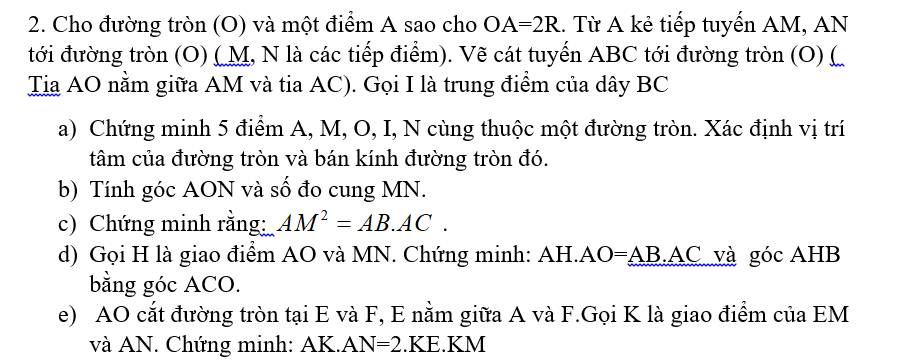Hãy nhập câu hỏi của bạn vào đây, nếu là tài khoản VIP, bạn sẽ được ưu tiên trả lời.

\(A=\left(4x^2+2\cdot2\cdot\dfrac{1}{4}x+\dfrac{1}{16}\right)-\dfrac{1}{16}=\left(2x+\dfrac{1}{4}\right)^2-\dfrac{1}{16}\ge-\dfrac{1}{16}\\ A_{min}=-\dfrac{1}{16}\Leftrightarrow2x+\dfrac{1}{4}=0\Leftrightarrow x=-\dfrac{1}{8}\)

\(A=\dfrac{2x+1}{4\sqrt{x}}=\dfrac{\sqrt{x}}{2}+\dfrac{1}{4\sqrt{x}}\ge2\sqrt{\dfrac{\sqrt{x}}{8\sqrt{x}}}=2\sqrt{\dfrac{1}{8}}=\dfrac{\sqrt{2}}{2}=\dfrac{1}{2}\cdot\sqrt{2}>\dfrac{1}{2}\left(cosi\right)\)


a: ΔOBC cân tại O
ma OI là trung tuyến
nên OI vuông góc BC
=>góc OIA=90 độ
góc OIA=góc OMA=góc ONA=90 độ
=>O,I,M,A,N cùng thuộc đường tròn đường kính OA
Tâm là trung điểm của OA
R'=OA/2=R
b: Xét ΔAON vuông tại N có cos AON=ON/OA=1/2
nêngóc AON=60 độ
=>góc MON=120 độ
sđ cung MN=120 độ
c: Xét ΔAMB và ΔACM có
góc AMB=góc ACM
góc MAB chung
=>ΔAMB đồng dạng với ΔACM
=>AM/AC=AB/AM
=>AM^2=AB*AC

\(c,\left\{{}\begin{matrix}\dfrac{2}{x-2}+\dfrac{1}{y+1}=3\\\dfrac{4}{x-2}-\dfrac{3}{y+1}=1\end{matrix}\right.\)
\(\Leftrightarrow\left\{{}\begin{matrix}\dfrac{4}{x-2}+\dfrac{2}{y+1}=6\\\dfrac{4}{x-2}-\dfrac{3}{y+1}=1\end{matrix}\right.\)
\(\Leftrightarrow\left\{{}\begin{matrix}\dfrac{2}{y+1}+\dfrac{3}{y+1}=5\\\dfrac{4}{x-2}-\dfrac{3}{y+1}=1\end{matrix}\right.\)
\(\Leftrightarrow\left\{{}\begin{matrix}\dfrac{5}{y+1}=5\\\dfrac{4}{x-2}-\dfrac{3}{y+1}=1\end{matrix}\right.\)
\(\Leftrightarrow\left\{{}\begin{matrix}y+1=1\\\dfrac{4}{x-2}-\dfrac{3}{y+1}=1\end{matrix}\right.\)
\(\Leftrightarrow\left\{{}\begin{matrix}y=0\left(2\right)\\\dfrac{4}{x-2}-\dfrac{3}{y+1}=1\left(1\right)\end{matrix}\right.\)
Thay \(\left(2\right)\) vào \(\left(1\right)\) :
\(\dfrac{4}{x-2}-\dfrac{3}{0+1}=1\)
\(\Rightarrow\dfrac{4}{x-2}-3=1\)
\(\Rightarrow\dfrac{4}{x-2}=4\)
\(\Rightarrow x-2=1\)
\(\Rightarrow x=3\)
Vậy hệ phương trình có nghiệm duy nhất \(\left(x;y\right)=\left(3;0\right)\)
c: =>4/x-2+2/y+1=6 và 4/x-2-3/y+1=1
=>5/y+1=5 và 2/x-2+1/y+1=3
=>y+1=1 và 2/x-2+1=3
=>y=0 và x-2=1
=>x=3 và y=0


